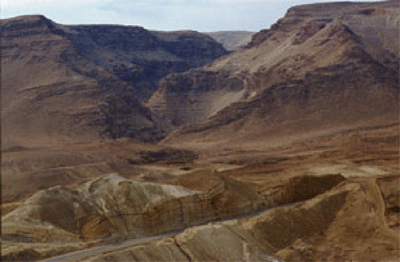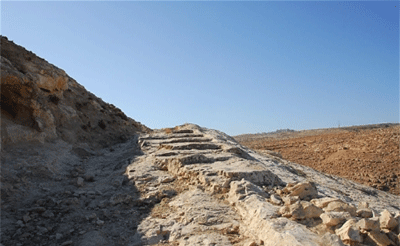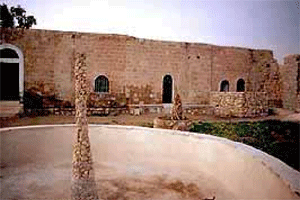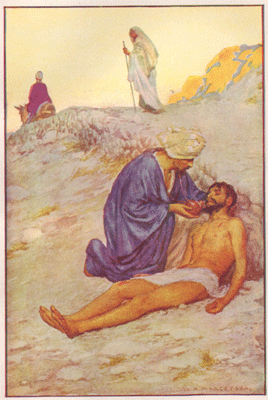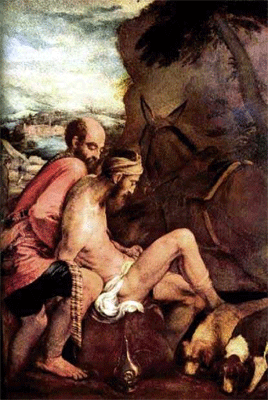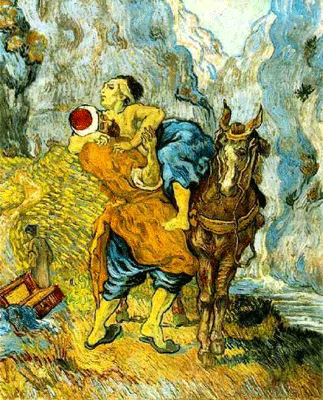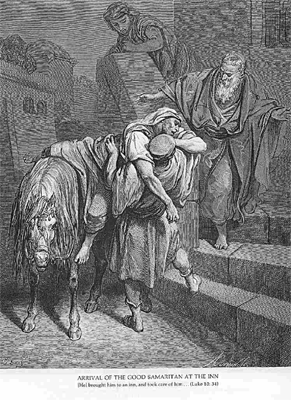
Christmas
Easter
Pentcoest
All Saints
Christ The King
Confirmation
Palm/Passion
Reformation
Stewardship
Books of the Bible
Lenten Series
Christmas Dramas
Videos
Series A - Matthew
Series B - Mark
Series C - Luke
Series D - Other
To contact
Edward F. Markquart
info@sfs.com

Series C PENTECOST 7C Luke 10:25-37 The following Bible study is from a larger course entitled, THE LIFE OF CHRIST: A Study in the Four Gospels. This 54 week course for the laity will be available for congregations in 2007. Basic text for the course: SYNOPSIS OF THE FOUR GOSPELS, Kurt Aland, English Edition, P. 168-170. Introductory Comments Last Journey to Jerusalem In this section of Luke 10-18, we are will focus on stories which are uniquely from the Gospel of Luke. This section is often called Luke’s “travel narrative” in which Jesus travels from Galilee to Judea/Jerusalem. We will study several stories which are unique to Luke such as: +to Jerusalem, (gospel lesson for this Sunday) +rejection by the Samaritans, (gospel lesson for this Sunday) +parable of the Good Samaritan, +Mary and Martha, +parable of the persistent friend at midnight, +parable of the rich fool, +parable of the being invited to a marriage banquet, +parable of the persistent widow, +and the parable of the Pharisee and the publican. All of these stories are unique to Luke and reveal his particular emphases, values and biases. We will also carefully study Jesus’ teachings from Q (Quella) which are found in this “travel" section. We remember that whenever there are exact parallels between Luke and Matthew, we conclude those two authors must have been copying from a third, earlier source which we call Q. Just as Matthew gathered several teachings from Q and placed those teachings in Jesus’ Sermon on the Mount (and elsewhere in Matthew,) so also Luke gathered several of Jesus’ teachings from Q and has placed them in this “travel document.” In this travel section of Luke 10-18, there are some of the finest passages of Scripture in the Bible. During this section, we will stop and pause before some of the most magnificent Bible passages such as the story of Mary and Martha, the parables of the Good Samaritan, the Grateful Samaritan, the Rich Fool, the Rich Man and Lazarus, the Great Banquet, the Marriage Feast, the Lost Sheep, the Lost Coin, the Lost Son (the Prodigal Son.) It is as if you are visiting the finest art galleries in the world and you stop to immerse yourself in the Hall of Mirrors in the Louve in Paris, or stop and silently examine the Pieta by Michelangelo in the Vatican, or stop to see grand dining room in the Hermitage in St. Petersburg, Russia. These places are the finest places in the art galleries of the world. Similarly, we will stop and pause before the most grand religious short stories in the world when we listen to these parables of Jesus in Luke 10-18. These parables of Jesus in Luke 10-18 have transformed human history and religion. We do not hurriedly pass by these parables, but we slow down, stop and listen to the wisdom of Jesus through these his common yet profound everyday stories from life. Summary Teachings About Luke Luke 1:1-4. “Inasmuch as many have taken to compile a narrative of the things which have been accomplished among us, just as they were delivered to us by those who from the beginning were eyewitnesses and ministers of the word, it seemed good to me also, having followed all things closely for some time past, to write an orderly account for you, most excellent Theophilus, that you may know the truth concerning the things of which you have been informed.” Theophilus’s name was a Gentile name. Theophilus was perhaps a Roman official. Luke persistently translated the language of Jewish customs so that a non-Jewish person could more clearly understand e.g. “master’ is substituted for “rabbi,” “lawyer” for “scribe,” and “verily” for “amen.” Luke’s gospel is comparatively free from Old Testament quotations and makes little use of arguments from prophecy as Matthew often does. In this gospel, the purpose of Jesus Christ is to save the whole world (including Samaritans and Roman centurions) and is not limited to saving the Jews first and the Gentiles later (as in Matthew.) Luke was a traveling companion of the Apostle Paul, and was with Paul when Paul wrote Colossians, Philemon, and 2 Timothy. Luke is mentioned in the following Bible passages: Colossians 4:14, “Luke, the beloved physician, and Demas greet you.” Philemon 14, “Epaphras, my fellow prisoner in Christ Jesus, sends you greetings as do Mark (John Mark, the author of the Gospel of Mark), Aristarchus, Demas, and Luke, my fellow workers.” II Timothy 4:11, “Luke alone is with me (here in prison). Get Mark (John Mark, the author of Mark’s gospel) and bring him with you. He is very useful in serving me. Irenaeus, an early Church Father: “Luke, the follower of Paul, recorded in a book the gospel which was preached by him.” Irenaeus, about 200 CE. The Muratorian fragment: “Luke, that physician, who after the ascension of Christ when Paul had taken with him as a companion on his journey, composed it in his own name on the basis of report.” Written in about 190 CE, the Muratorian Fragment is a list of 22 of our 27 books of the New Testament. There are brief remarks about the origins of each of the books. The Muratorian Fragment is a pivotal document, the first “official” list of what books are to be included in the New Testament. Characteristics of Luke-Acts The Gospel of the poor and outcast. The following stories are found only in Luke’s gospel: Mary’s song of poverty (1:51-53), the poor have good news preached to them (4:18), the disciples left everything and followed him (5:11), beatitudes of poverty (6:20-25), parable of the rich fool (12:33-34), followers to renounce all that they have (14:25-33), parable of the unrighteous steward (16:1-13), parable of the rich man and Lazarus (16:19-31), story about Zacchaeus (19:1-10.) The Gospel of Womanhood. The following stories are found only in Luke’s gospel:: the widow Anna, the widow of Nain (7:11-12), the band of women who follow Christ (8:1-3), Mary and Martha (10:38), the woman with a disease (13:10-17), the parable of the woman and the lost coin (15:8-16), the widow who insisted on her rights (18:1-8), the daughters of Jerusalem weeping at the foot of the cross (23:27). The Gospel of Tolerance. The following stories are found only in Luke’s gospel: James and John rebuked for wanting to destroy a Samaritan village (9:52-56), the parable of the Good Samaritan (10:29-37), the story of the grateful leper (17:11-19). The one in ten healed people was a Samaritan. The Gospel of Prayer. The following stories/incidents are found only in Luke’s gospel: at Jesus’ baptism, before choosing the twelve disciples, on return of the seventy, the parable of the persistent friend, the parable of the woman and the unjust judge. The Gospel of the Holy Spirit. The following stories/incidents are found only in Luke’s gospel: The Holy Spirit was upon the Baptist (1:15-17), Mary, Elizabeth 1:35, 41), Zechariah (1:67), Simeon, Jesus at his baptism (4:1, 14), Jesus during his first sermon (4:18), and on the seventy. This gospel has been called the Gospel of the Holy Spirit e.g. Luke 11:13, “How much more will the heavenly Father give the Holy Spirit to those who ask him.” We remember that Luke’s companion volume, the book of Acts, is all about the activity of the Holy Spirit on people’s lives. The Gospel of Evangelism/Mission/Conversion of the Gentiles. As students of the Scriptures, we always need to remember that Luke also wrote the Book of Acts which is the greatest evangelism document ever written. Luke knows that the Jesus Story in the Gospel of Luke becomes the Church Story in the Book of Acts. The Gospel of Luke records the acts of Jesus and the Book of Acts records the “acts of the apostles.” The story of the Samaritans in this section is a prelude to the mission to the Samaritans in the Book of Acts. The Gospel of Joy. The following stories/incidents are found only in Luke’s gospel: the three hymns in Jesus’ infancy story, after the return of the seventy.
#182. THE LAWYER’S QUESTION;
We will examine Luke’s version of this story. Luke inserts the story of the lawyer here because this story fits perfectly with Luke’s next story about the Good Samaritan. In fact, in Luke’s gospel, the story of the lawyer’s question and the parable of the Good Samaritan are essentially one story. It is the combination of these two episodes that create one of the finest stories ever told. -A lawyer stood up and put him/Jesus to the test. Circle the word, “lawyer.” Note that Matthew’s version of the story also has a lawyer asking the important question. The functions of a lawyer and scribe were identical. Scribes were lawyers. The word, “lawyer” is used only three times in the New Testament. The more common description was “scribe.”
Importantly, again and again, people were testing Jesus in order to discover who he really was and what he was all about. The same is true two thousand years later. -Teacher, what shall I do to inherit eternal life? This is a basic, universal question that is asked by almost all human beings, even today. In Mark and Matthew, the question is more of a Jewish question. That is, “What is the greatest/first commandment of the law?” Mark and Matthew were asking a fundamental Jewish question; Luke was asking a fundamental universal question. Luke’s gospel was written with words and thought patterns which appealed to a larger world. -What is written in the law? How do you read it? Jesus asked the lawyer what was written in the sacred laws of Judaism. -You shall love the Lord your God with all your heart, all your soul, all your strength and all your mind. This is the basic commandment of Jesus and of God and of life. We are to love God with all our heart, with all our soul and spiritual emotions, with all the strength and vitality of our inner lives, and with all our brains and human brilliance (or lack thereof). This is what God wants from us more than anything else. God wants us to love God with “all” that is within us. This is a quotation from Deuteronomy 6:4, the Shema, the basic tenet of Judaism. Circle the word, “all,” four times. -And (love) your neighbor as yourself. Jesus quoted Leviticus 19:18b. This was the first time in human civilization that any person has ever uttered this sacred combination: “the love of God and the love of neighbor.” The two laws were combined into one moral law. Neither law was to stand on its own; the two laws were to be intertwined and inner-connected. Like a spinning double helix, they belonged and swirled together. The second commandment of Jesus is not so much a psychological truism (“We human beings are to have an inner healthy love and acceptance of our selves, whereby we can truly love someone else.”) as a religious truism (“We human beings are to focus on our neighbors needs as much as we do our own.”) -Jesus said to him, “You have answered rightly. Do this and you will live.” This is at the heart of the teachings of Jesus. We are not simply to mouth these words, pray these words, think these words, philosophize about these words but we are to do them. When we do these teachings, we find life and we will live. In Mark’s version of the story, Jesus states a similarly profound teaching: “When Jesus saw that he answered wisely, he said, ‘You are not far from the kingdom of God.’” When we hear these words, we know that we are close to the center of Christianity, that we are close to the heart of God. The cross of Christ, the most important symbol of the Christian faith, has two dimensions: a vertical love to God and a horizontal love towards our neighbors. The vertical dimension is first and the horizontal dimension is second. That is why the first commandment is called the “first” commandment and the second is called the “second.” Jesus said, “Do THIS and you shall live. The word, THIS, is singular. There are not two commandments but one commandment. It is as if Jesus treated the two commandments as one and that they could not be separated. A person cannot have a cross without its two dimensions: vertical and horizontal. This is not a “works righteous” kind of religion. That is, a person does not do works of love in order to be saved. It is just the opposite. Because we are saved and God’s love lives within us, therefore we have hearts of love and do acts of love. This is “because-therefore” religion and not “if-then” religion. Because God loves us and God’s love lives within us, therefore love flows out of us from God. This is not “if-then” religion; if we are good and loving, then God’s love lives in us; if we are loving, then we are saved. -But he/the lawyer, desiring to justify himself, said to Jesus, “And who is my neighbor?” This is fundamental in life. If Jesus invites us to deeply love God first and deeply love our neighbor second, and the two cannot be separated, the almost inevitable question is: “Who is my neighbor?” Is “my neighbor” referring to one’s spouse, children, grandchildren, friends, people at church or work or living next door? How one defines “my neighbor” is immensely important. -Jesus replied, “A man was going down from Jerusalem to Jericho.” This story is one of the most loved and famous stories in all of literature. The “feel” of this parable is much different than the beginning parables that we studied in Matthew e.g. the parables of the sower, the pearl, the net, etc. Those parables in Matthew 13 are more like analogies. This is a wonderful, well-crafted literary story. By creating this touching and realistic story, Jesus shared with us a profound moral, spiritual and emotional truth about God’s way of living and loving. It is beneficial to examine the following link to “experience” the road from Jericho to Jerusalem. This link will take thirty seconds to download, but it is definitely worth the wait. Jericho to Jerusalem (from the above website)
Parts of the Roman road are still visible in places, and the way today is safe and pleasant. We didn't see any thieves, but did make a stop at the traditional "Inn of the Good Samaritan" (Luke 10:25-37).” Pictured below is the area of the road from Jerusalem to Jericho.
http://gbgm-umc.org/images/photobank/f0214.jpg
Parts of the ancient Roman road (the Romans were great road builders) are still visible. _____________________________________________________________________________ -A man fell among robbers. There was a seventeen mile road from Jerusalem down to Jericho and it was known to be filled with robbers. -By chance, a priest was going down that road. Jewish priests were overwhelmingly present in and around Jerusalem. -He/the priest passed by on the other side of the road. We have heard the advice often: “Don’t get involved with suffering and hurting people. You may get hurt yourself.” -So likewise, a Levite passed by on the other side of the road. A Levite is another form of priest. We know what happens. Same story; second verse. -But a Samaritan. This is the issue. The Samaritan man was thought to possess a false religion and was not part of the true faith, but he, of all people, stopped to help. Samaritans were the traditional enemy of the Jews. The Samaritans and Jews did not mix with each other nor intermarry with each other. They had different centers of worship, different capital cities, and different Bibles. “In Jewish eyes Samaritans were half-breeds, ethnic traitors, bad guys. When the nation was divided, Samaria was originally a name for the capital of the northern kingdom founded by Omri (1 Kings 16:21-24). Samaritans intermarried with other peoples in the region. They even worshiped at a different site, Mount Gerazim (Jn 4:20-24). Many recognized only the Pentateuch as inspired. Traditionally Jews and Samaritans were hostile to one another. So Jesus' effort to reach out to them is culturally exceptional. It would be like ministering in a cross racial setting today. The reaction might be "What are you doing here?" and "Can you believe he ministers to them?" -When he saw him, he had pity/compassion/mercy. An outsider had compassion. Compassion is an inner feeling of love and sympathy within the heart. Out of a heart of compassion, flows rivers of compassion. There is first a heart of compassion and then, from that loving heart, flow many acts of compassion. This is so basic and so true. -He went to him, bound his wounds, pouring on oil and wine, put him on his own beast, brought him to the inn, and took care of him. -The next day, he took out two days of wages and gave them to the innkeeper, saying, “Take care of him. And whatever more you spend, I will repay you when I come back.” There are several specific deeds of compassion for the man who had been hurt in the robbery. As we read these verses, circle the words that show specific compassionate actions by the Samaritan. The Samaritan:
There are at least twelve specific actions of mercy towards the victim of the robbery. The heart of love does specific deeds of love.
http://www.ourfatherlutheran.net/biblehomelands/palestine/palestinepix/goodsamaritan.jpg Below is a photograph of what is known as “The Good Samaritan Inn.” It is located on the road between Jericho and Jerusalem. -Which of these three, do you think proved to be neighbor to the man who fell among robbers? -He/the lawyer said, “The one who showed mercy on him.” This is the key. Mercy and compassion are the same word. -Go and do likewise. We recall Jesus’ teaching to the lawyer earlier in the story when Jesus said to the lawyer: “Do this. And you shall live.” Do. “Love God with all your heart, soul and mind. Love your neighbor as yourself. Do this and you shall live.” It is as if the two commandments are treated as one: Do THIS. Not DO THESE.
What Is Jesus' Message In This Story?
Based on your discussion in your groups, are there any further insights that you feel are part of the message of the parable of the Good Samaritan? The parable of the Good Samaritan has inspired the hearts, minds and creativity of the world’s best artists and painters. Carefully examine the following paintings. What do you see in each of the paintings? Painting And Imagination The following website is your link to hundreds of religious paintings from museums around the world. When the paintings are projected onto a screen, they are larger and a viewer can see more of the details within that painting. Below… http://www.mainlesson.com/books/hurlbut/bible/zpage600.jpg
Below: http://perso.wanadoo.fr/maurice.lamouroux/files/ill_e%20NT.htm Parable of the good samaritan / BASSANO,17,ITA,THE GOOD SAMARITAN
Below… Parable of the good amaritan / GOGH,19,FRA,THE GOOD SAMARITAN, OTTERLO
Below… Parable of the good samaritan / DORE,19 THE GOOD SAMARITAN AT THE INN L10,FRA,ARRIVAL OF
Please read the following sermon. Pentecost 7 |
|
| LAS |
